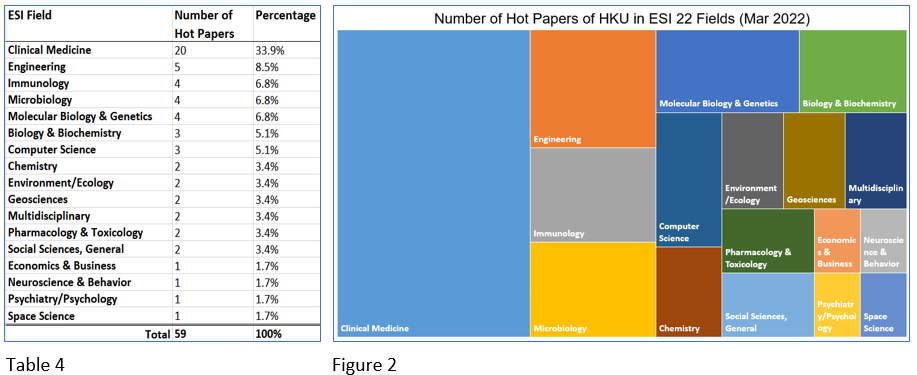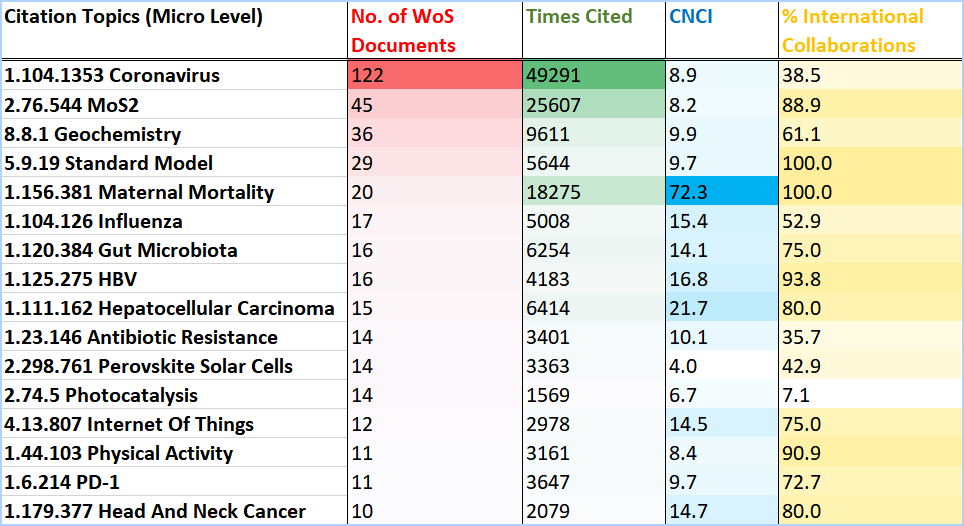
Analysis of University Research Performance by Using ESI and InCites
— by Stella Chow
About Essential Science Indicators (ESI)
Essential Science Indicators (ESI) is an analytical tool that helps identify top-performing research on the Web of Science (WoS) Core Collection. ESI surveys more than 11,000 journals from around the world to rank authors, institutions, countries, and journals in 22 broad fields based on publication and citation performance. The survey data covers a rolling 10-year period and includes bi-monthly updates of rankings and citation counts. ESI is also a useful tool for analyzing and benchmarking research performance, identifying significant trends of research, ranking top performers, and evaluating potential employees and collaborators. For more about ESI, visit the ESI LibGuide by Clarivate.
About InCites Benchmarking & Analytics (InCites)
InCites Benchmarking & Analytics (InCites) is a customized, web-based research evaluation tool that helps develop research strategy, analyze institutional productivity, monitor collaboration activity, identify influential researchers, showcase strengths, and discover areas of opportunity. For more about the InCites, visit the InCites LibGuide.
In this post the HKU Libraries subscribed databases, (i) InCites Essential Science Indicators (ESI) and (ii) InCites (Benchmarking & analytics) (InCites), are used to explore the research performances of HKU in terms of (1) field ranking; (2) Highly Cited Papers and Hot Papers; and (3) Citation Topics of Top Papers.
Notes 1:
- The updated bi-monthly ESI data which were released on 10 March 2022 are covered from January 2011 to December 2021.
- The data were extracted from ESI and InCites on 29 April 2022.
1. Field Ranking
According to the latest ESI data released in March 2022, HKU has twenty fields are in the Top 1 % on the ESI 22 Field Ranking2. Among these twenty fields, Clinical Medicine, Engineering, and Social Sciences General are in the Top 1‰.
The numbers of the WoS documents, Cites, Cites/Paper and the Top Papers of these three fields are given in Table 1 below.
| Fields | WoS Documents | Cites | Cites/Paper | Top Papers |
| Clinical Medicine | 10020 | 298738 | 29.81 | 311 |
| Engineering | 4477 | 81676 | 18.24 | 104 |
| Social Sciences General | 4798 | 51371 | 10.71 | 79 |
Note 2: Field ranking in ESI:
The Field Rankings table displays aggregate data for each of the 22 ESI research fields. For each field,
- the number of papers is the total number of papers in 10 years of Web of Science.
- the number of citations is the total number of citations received by all papers in the research field. The citing papers can be in any field.
- Citation per Paper is the total number of citations divided by the total number of papers.
- Highly Cited Papers is the number of papers receiving the minimum number of citations to place them in the top 1% of all papers in the field. It is important to recognize that the minimum number may be equivalent to the value given in the citations per paper column. It may be smaller, or it may be larger.
(Source: InCites Essential Science Indicators Help: Field Rankings (May 2022)
2. Highly Cited Papers and Hot Papers
2A. Highly Cited Papers
The latest released ESI data in March 2022 show that HKU has 1070 Highly Cited Papers3. The numbers of Highly Cited Papers in the ESI 22 fields are given in Table 2 below. The proportions of these papers in the ESI 22 fields are shown in Figure 1. The Clinical Medicine field has 309 Highly Cited Papers, which accounts for the highest number of Highly Cited Papers (28.9%), followed by Engineering (104 Highly Cited Papers, 9.7%) and Physics (94 Highly Cited Papers, 8.8%).

Note 3: Highly Cited Papers are those which have received enough citations for being placed in the top 1% when compared to all the other papers published in the same year and in the same field, for instance, the 2008 Physics papers are only compared to the other 2002 Physics papers. (Source: Essential Science Indicators: Learn the Basics LibGuide, (May 2022)
The top 5 Highly Cited Papers with the highest number of citations are shown in Table 3.
| Article Titles of the Top 5 Highly Cited Papers | Research Field | No. of Citation |
| Clinical Characteristics Of Coronavirus Disease 2019 In China Guan, W., Ni, Z., Hu, Y., and more (2020). The New England Journal of Medicine, 382(18), 1708-1720 | Clinical Medicine | 10562 |
| Global And Regional Mortality From 235 Causes Of Death For 20 Age Groups In 1990 And 2010: A Systematic Analysis For The Global Burden Of Disease Study 2010 Lozano, R., Naghavi, M., Foreman, K., and more (2012). The Lancet (British Edition), 380(9859), 2095-2128 | Clinical Medicine | 6562 |
| A Comparative Risk Assessment Of Burden Of Disease And Injury Attributable To 67 Risk Factors And Risk Factor Clusters In 21 Regions, 1990-2010: A Systematic Analysis For The Global Burden Of Disease Study 2010 Lozano, R., Naghavi, M., Foreman, K., and more (2012). The Lancet, 380(9859), 2224-2260 | Clinical Medicine | 6215 |
| A Global Reference For Human Genetic Variation Altshuler, DM., Durbin, RM., Abecasis, GR., and more (2015). Nature (London), 526(7571), 68-74 | Molecular Biology & Genetics | 5111 |
| Biological Insights From 108 Schizophrenia-Associated Genetic Loci Ripke, S., Neale, BM., Corvin, A., and more (2014). Nature, 511(7510), 421-427 | Molecular Biology & Genetics | 4115 |
2B. Hot Papers
In the updated ESI data in March 2022, HKU has 59 Hot Papers4. The numbers of these papers in the ESI 22 fields are shown in Table 4. The proportions of these Hot Papers are plotted in Figure 2. Of the Hot Papers, 20 are about the Clinical Medicine field, accounting for nearly one-third (33.9%) of the total number of Hot Paper, followed by Engineering (8.5%) and Immunology, Microbiology, and Molecular Biology & Genetics (6.8%).

Note 4: For Hot Papers, only those papers published in the last 2 years are considered. Hot Papers receive citations quickly after publication. They are cited enough times in the most recent bi-monthly period and are placed in the top 0.1% when compared to the peer papers. Peer papers are those which are in the same field and were added to WoS Core Collection in the same bi-monthly update. (Source: Essential Science Indicators: Learn the Basics LibGuide, (May 2022)
The top 5 Hot Papers with the highest number of citations are given in Table 5.
| Article Titles of the Top 5 Hot Papers | Research Field | No. of Citation |
| Clinical Characteristics Of Coronavirus Disease 2019 In China Guan, W., Ni, Z., Hu, Y., and more (2020). The New England Journal of Medicine, 382(18), 1708-1720 | Clinical Medicine | 10562 |
| A Familial Cluster Of Pneumonia Associated With The 2019 Novel Coronavirus Indicating Person-To-Person Transmission: A Study Of A Family Cluster Chan, JFW., Yuan, SF., Kok, KH., and more (2020). The Lancet (British Edition), 395(10223), 514-523 | Clinical Medicine | 3483 |
| The Species Severe Acute Respiratory Syndrome-Related Coronavirus: Classifying 2019-Ncov And Naming It Sars-Cov-2 Gorbalenya, AE., Baker, SC., Baric, RS., and more (2020). Nature Microbiology, 5(4), 536-544 | Microbiology | 2846 |
| Detection Of 2019 Novel Coronavirus (2019-Ncov) By Real-Time Rt-Pcr Corman, VM., Landt, O., Kaiser, M., and more (2020). Euro Surveillance: Bulletin Européen Sur Les Maladies Transmissibles, 2020-01-23, Vol.25 (3) | Immunology | 2716 |
| Early Transmission Dynamics In Wuhan, China, Of Novel Coronavirus-Infected Pneumonia Li, Q., Guan, XH., Wu, P., and more (2020). The New England Journal of Medicine, 382(13), 1199-1207 | Clinical Medicine | 1989 |
3. Citation Topics of Top Papers
When analyzing the ESI Top Papers under the Citation Topics5 schemas (Micro-topics Level) in InCites, the 15 Citation Topics with the higher number of WoS Documents are listed in Table 6 and plotted in Figure 3.
Among these topics, Coronavirus (Clinical & Life Sciences) has the highest number of WoS documents. MoS2 (Chemistry), Geochemistry (Earth Sciences), and Standard Model (Physics) also have a higher number of WoS Documents.

The proportions of these Citation Topics in these WoS documents are presented in Figure 3.

When investigating the Category Normalized Citation Impact (CNCI)6 of the 15 Citation Topics in Figure 4, Maternal Mortality (Clinical & Life Sciences) has the highest CNCI (72.3), followed by Hepatocellular Carcinoma (Clinical & Life Sciences; CNCI: 21.7) and HBV (Clinical & Life Sciences; CNCI: 16.8).
For % International Collaborations7, Maternal Mortality (Clinical & Life Sciences) and Standard Model (Physics) are completely internationally collaborated. The Citation Topics of HBC (Clinical & Life Sciences), Physical Activity (Clinical & Life Sciences), and MoS2 (Chemistry) are also high in % International Collaborations, for instance, 93.8%, 90.9%, and 88.9% respectively.

Figure 4. (X-axis: Web of Science Documents; Y-axis: % International Collaborations; Point Radius: Category Normalization Citation Impact (CNCI))
Note 5: Citation Topics are algorithmically derived citation clusters, using an algorithm developed by CWTS, Leiden. This is a three-level hierarchical document-level classification system. The three levels of the hierarchy and their content according to the 2021 clustering are Macro-topics (10); Meso-topics (326); and Micro-topics (2444) (Source: Clarivate Incites Help: Research Areas Schemas: Citation Topics (May 2022)
Note 6: InCites, it offers a field-normalized metric named the Category Normalized Citation Impact (CNCI) benchmarking the impact of an article in a particular subject area. The CNCI value of “1” represents performance at par with the world average; above “1” is above average; below “1” is below the average. (Source: Research Metrics@HKUL: Article Level Metrics: Category Normalized Citation Impact (CNCI) (May 2022))
Note 7: The International collaborations indicator counts papers that contain one or more international co-authors. On InCites, the % of International Collaborations is an indication of an institution’s or author’s ability to attract international collaborations using the data from the Web of Science. The formulation of the score is the number of International Collaborations for an entity divided by the total number of documents for the same entity represented as a percentage. (Source: Research Metrics@HKUL: Collaboration Metrics: % International Collaborations (May 2022))
The HKU Libraries are now offering the Bibliometrics and Impact Services to the HKU faculties and/or departments that are interested in analyzing the research performance and institutional productivity, identifying the research trends, ranking the top performers, and monitoring the collaboration activity within the faculties and departments or internationally. The faculties and departments will receive assistance in aggregating the data available on ESI and InCites in accordance with the individual faculty or department’s preference. Contact us at scholarlycomm@hku.hk, if interested or if you have any questions.
References
Clarivate Analytics. (2022). Clarivate InCites Help: Citation Topics. Clarivate Analytics. https://incites.help.clarivate.com/Content/Research-Areas/citation-topics.htm
Clarivate Analytics. (2022). Essential Science Indicators: See where science is going and who’s leading the way. Clarivate Analytics. https://clarivate.com/webofsciencegroup/solutions/essential-science-indicators/
Clarivate Analytics. (2022). InCites Essential Science Indicators: Field Rankings. Clarivate Analytics. http://help.incites.clarivate.com/incitesLiveESI/ESIGroup/indicatorsGroup/fieldBaselines/fieldRankings.html
Faeth, K. (2021, Jul 7, 2021). LibGuides: Essential Science Indicators: Learn the Basics. Clarivate Analytics. https://clarivate.libguides.com/c.php?g=593878&p=4107958
Matthews, T. (2022, Feb 3, 2022). LibGuides: InCites Benchmarking & Analytics: Learn the Basics. Clarivate Analytics. https://clarivate.libguides.com/incites_ba
The University of Hong Kong Libraries. (May 1, 2022). LibGuides: Research Metrics@HKUL: Article Level Metrics: Category Normalized Citation Impact (CNCI). The University of Hong Kong Libraries. https://libguides.lib.hku.hk/c.php?g=945929&p=6852303#s-lib-ctab-21971064-0
The University of Hong Kong Libraries. (May 1, 2022). LibGuides: Research Metrics@HKUL: Research Metrics@HKUL: Collaboration Metrics: % International Collaborations. The University of Hong Kong Libraries. https://libguides.lib.hku.hk/c.php?g=945929&p=6852305#s-lib-ctab-21971112-0


